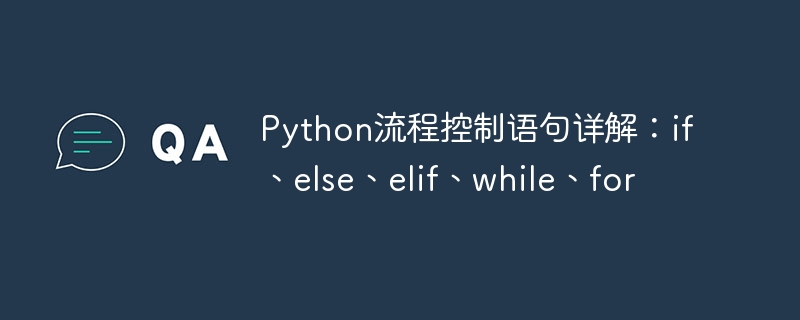Home >Backend Development >Python Tutorial >In-depth analysis of Python flow control statements: the use of if, else, elif, while, and for
In-depth analysis of Python flow control statements: the use of if, else, elif, while, and for
- PHPzOriginal
- 2024-01-20 10:21:161184browse

Detailed explanation of Python flow control statements: if, else, elif, while, for
In programming, flow control statements are essential. They are used to Conditions determine the execution flow of a program. Python provides several commonly used flow control statements, including if, else, elif, while and for. This article explains these statements in detail and provides specific code examples.
- if statement
The if statement is used to determine whether a certain condition is true. If the condition is true, the statement in the if code block is executed; if the condition is false, the if code block is skipped. . Its basic grammatical structure is as follows:
if 条件:
代码块The following is a simple example to determine whether a number is greater than 10:
num = 15
if num > 10:
print("数字大于10")- else statement
else statement immediately follows After the if statement, it is used to handle the situation where the if condition is false. When the if condition is true, the statements in the if code block are executed; when the if condition is false, the statements in the else code block are executed. Its syntax structure is as follows:
if 条件:
代码块1
else:
代码块2The following is an example to determine whether a number is even:
num = 9
if num % 2 == 0:
print("数字为偶数")
else:
print("数字为奇数")- elif statement
elif statement is used to handle multiple conditions In this case, you can follow an if statement with multiple elif statements, and finally you can choose to add an else statement. The elif statement will only be executed when all previous conditions are not met. Its syntax structure is as follows:
if 条件1:
代码块1
elif 条件2:
代码块2
else:
代码块3The following is an example, evaluated according to the grade:
score = 85
if score >= 90:
print("优秀")
elif score >= 80:
print("良好")
elif score >= 70:
print("中等")
elif score >= 60:
print("及格")
else:
print("不及格")- while statement
The while statement is used to repeatedly execute a block of code if the condition is true. As long as the condition is true, the statements in the loop body will continue to be executed, and the loop will not stop until the condition is false. Its syntax structure is as follows:
while 条件:
代码块The following is an example to calculate the cumulative sum from 1 to 10:
sum = 0
num = 1
while num <= 10:
sum += num
num += 1
print("累加和为:", sum)- for statement
The for statement is used to iterate through a Sequence (such as list, string, etc.), take out each element in the sequence in turn. Its syntax structure is as follows:
for 变量 in 序列:
代码块The following is an example to calculate the sum of all elements in the list:
nums = [1, 2, 3, 4, 5]
sum = 0
for num in nums:
sum += num
print("列表的和为:", sum)Summary:
This article introduces the flow control statement in Python: if, else, elif, while and for. These statements can determine the execution flow of the program based on conditions, making the program more flexible and controllable. We demonstrate the usage of these statements through specific code examples, hoping to help readers have a deeper understanding.
The above is the detailed content of In-depth analysis of Python flow control statements: the use of if, else, elif, while, and for. For more information, please follow other related articles on the PHP Chinese website!

